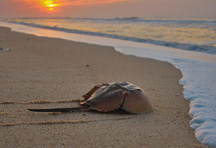by Dell Cullum

In a place that has an incredible variety of amazing wild and marine life species, it shouldn’t surprise you that one of those species has been here longer than the dinosaur. In fact 200 million years before the dinosaur, as far back as 450 million years ago. That means these creatures have survived five mass extinctions.
I’m talking about the horseshoe crab, and if you’ve never seen one, you can set your watch to the evening high tide of both the new and full moons of May and June, every year. This is when they travel in shallow waters along several Long Island shorelines, as well as eastern shorelines from Maine to Mexico, and the males breed with the egg laying females. I observe this timeless Paleozoic phenomenon each year at Lazy Point in Amagansett, along the shores of the beautiful Napeague Harbor.
 Here are some really cool facts about Limulus Polyphemus or, the horseshoe crab. First, they are more closely related to spiders, ticks and scorpions (arachnids) then they are to a typical decapod crab. They are very closely related to the extinct sea scorpions (eurypterids), which include some of the largest anthropoids to have ever existed. The horseshoe crab has two compound eyes, two median eyes (which can detect both visible and ultraviolet light), two lateral eyes, two ventral eyes (located underneath the shell next to the mouth), a endoparietal eye and many photoreceptors on the tail or telson. Despite having pretty bad eyesight, their eyes have the largest rods and cones of any known animal, almost a hundred times larger than the human eye. This has led to medical research using the horseshoe crab to aid in human eye study.
Here are some really cool facts about Limulus Polyphemus or, the horseshoe crab. First, they are more closely related to spiders, ticks and scorpions (arachnids) then they are to a typical decapod crab. They are very closely related to the extinct sea scorpions (eurypterids), which include some of the largest anthropoids to have ever existed. The horseshoe crab has two compound eyes, two median eyes (which can detect both visible and ultraviolet light), two lateral eyes, two ventral eyes (located underneath the shell next to the mouth), a endoparietal eye and many photoreceptors on the tail or telson. Despite having pretty bad eyesight, their eyes have the largest rods and cones of any known animal, almost a hundred times larger than the human eye. This has led to medical research using the horseshoe crab to aid in human eye study.
Another little known fact is that the Horseshoe crab normally swims upside down. This can sometimes result in landing on the top of their hard shell, or carapace. That is where that long saber like tail comes in. Contrary to rumor, the horseshoe crab tail is not used for attacking or defense. It is simply a tool used for navigation and to flip itself upright. The spines however, on both sides of the abdomen shell section (opisthosoma) are hard, sharp pointed, and movable. They are used for protection against predators, which include sea turtles, horse conch and sharks. Although horseshoe crabs are harmless to humans, caution is recommended when picking them up. Please don’t pick them up by the tail as this could result in injury to the crab. Accidentally slipping a finger in the hinge (between carapace and abdomen) can result in injury to the person picking up the crab.
Horseshoe crabs can stay out of the water for 4 days, as long as they keep their book gills moist. Those who get stranded during the spawn will bury themselves in the sand or they will fold themselves in half to retain moisture until the tide comes back in. Like all arthropods, horseshoe crabs shed (molt) their exoskeleton in order to grow. They will molt at least 6 times in their first year, and roughly 18 times before reaching sexual maturity when the horseshoe crab will stop molting. Females are larger and will molt less frequently to reach their larger size. Males and females can best be identified by the crabs second appendage. Females will have pinchers while the males have a special hook shaped claw that is used to lock itself onto the carapace of a female during breeding.
This year I had the pleasure of assisting Cornell University Cooperative Extension, as an East Hampton Town Trustee member volunteer, and did several counts and even helped tag 25 specimens for a growing study on the species. Sadly, in 2014, the horseshoe crab showed a severe decline in numbers for the first time in recorded history reaching “near threatened” status. The reasoning for this should also come as no surprise, as humans are undoubtedly the cause.
Nearly 500,000 horseshoe crabs are harvested annually by the biomedical industry for their blood. The blood contains amebocytes, which is used to make Limulus amebocyte lysate, which in turn is used for the detection of bacterial endotoxins in medical applications. The process doesn’t kill too many of the donors however, a small percentage do perish during the process, and after the process some females stop producing eggs. The price for a quart of this blood on the pharmaceutical market,… $15,000. Shoreline development has also been a big factor in the decline of horseshoe crab numbers. Fisheries also use the crab for bait to fish for eels and whelk (conch).
So the next time you are swimming in the ocean or the bay, remember you could be swimming with living fossils that predate the dinosaur, and they will gladly share their space with you.
Love Wildlife. It Matters.
~ Dell Cullum
Evelyn Alexander Wildlife Rehab and Rescue: 631-728-WILD
Hampton Wildlife: 631-377-6555

